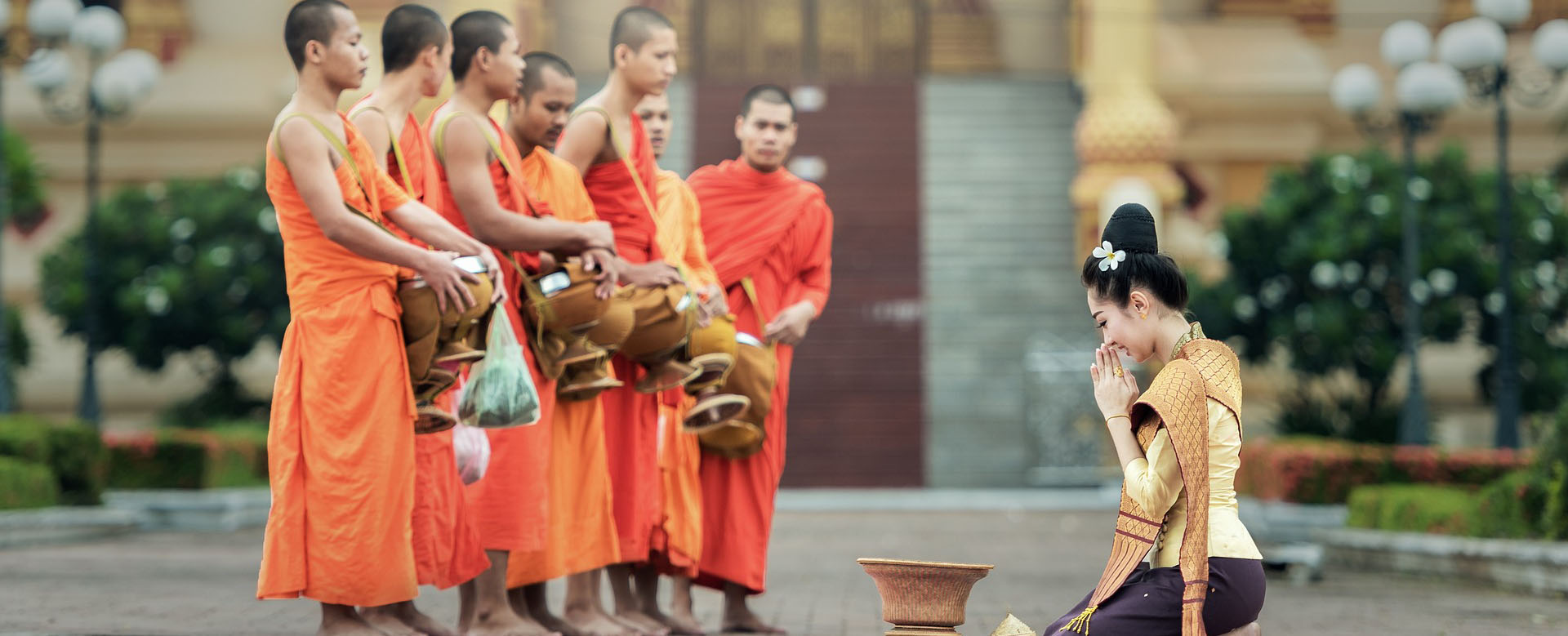Top 10 must-see Laos temples
The temples below with their captivating intricate and profound spiritual significance, will offer you a window into the heart of Laotian culture.
Pha That Luang
-
Location: That Luang village, Xaysettha district, Vientiane Capital
-
Opening hours: 8 AM - 4 PM
-
Fee: 5000 Kip per person (~ 0.25 USD)
At the top of the list, Pha That Luang, also known as the Great Stupa is one of the most stunning and well-known Laos temples.
Dating back to the 3rd century, it has undergone several reconstructions over the centuries. The most significant restoration occurred in the 16th century during the reign of King Setthathirath. Pha That Luang's striking golden exterior, which glistens in the sunlight, is a testament to its importance.

Pha That Luang
A central spire, known as a "sikhara" or "hti" in Lao architecture, rises above the stupa's pinnacle. This ornate spire is topped with a stylized parasol, symbolizing protection and royalty. It is a common architectural element in many Southeast Asian stupas.
This sacred site is not only a place of worship and pilgrimage for Buddhists but also a testament to Laos' ưrich history and spiritual heritage. I’m sure that every visitor will be captivated by the peaceful atmosphere of the temple grounds when visiting here.
Wat Xieng Thong
-
Location: At the end of the Luang Prabang peninsula between Khem Khong Road and Sakkaline Road.
-
Opening hours: 8 AM - 5 PM
-
Fee: 20,000 Kip per Person (~0.99 USD)
In 1995, Wat Xieng Thong was recognized as a UNESCO World Heritage Site as part of the larger Luang Prabang Historic Center. This recognition underscores its cultural and historical importance not only to Laos but also to the world.
Wat Xieng Thong was constructed in 1560 during the reign of King Setthathirath. It served as a royal temple under the Lao monarchy. Many Lao kings were crowned and important royal events took place within its sacred precincts.

Wat Xieng Thong
The most outstanding feature of Wat Xieng Thong is the multi-tiered roofs that curve gracefully toward the ground with stunning, intricate gilded patterns. These patterns depict mythical creatures and stories from Buddhist cosmology, which adorn the structure of Wat Xieng Thong.
Wat Sene Souk Haram
-
Location: Luang Phrabang
-
Opening hours: 8 AM – 6 PM daily
-
Fee: Free
Wat Sene Souk Haram, one of the most exquisite Laos temples, was built in 1718 during the reign of King Kitsarath. Its name means "Temple of 100,000 Treasures" reflecting the temple's historical importance as a repository of Buddhist teachings and texts.
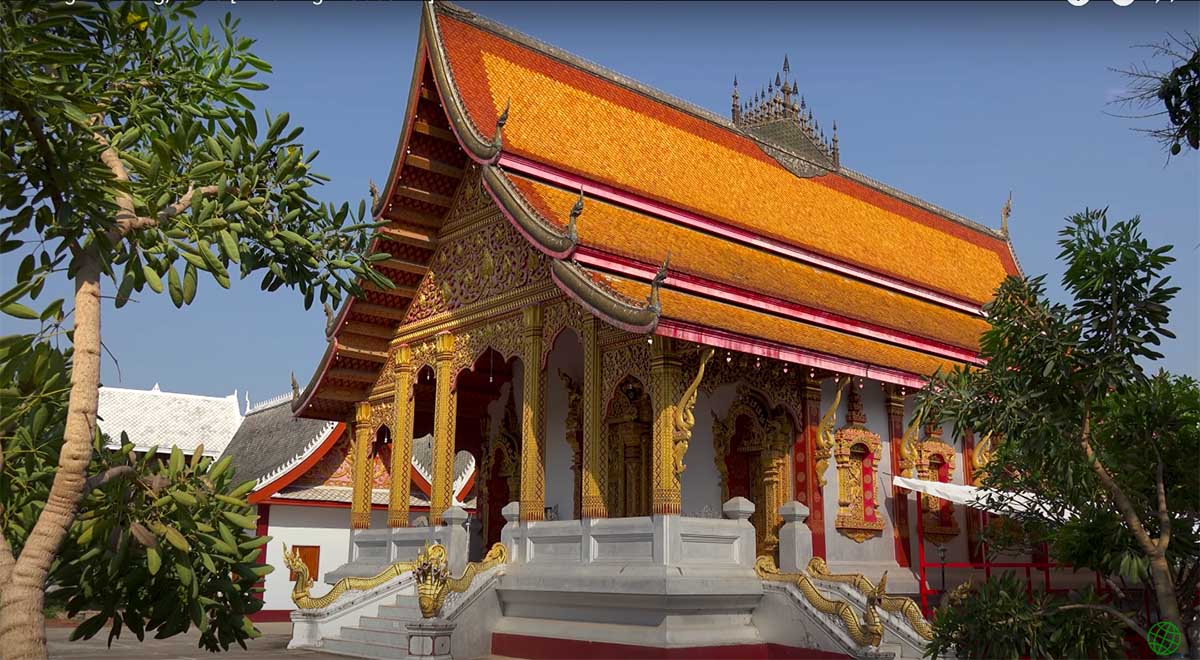
Wat Sene Souk Haram
Wat Sene Souk Haram is known for its vibrant celebrations during Laos New Year (Songkran) and other important festivals. During these festivities, the temple becomes a hub of activity, with locals and tourists participating in:
-
Religious ceremonies
-
Traditional dance performances
-
The famous water-throwing rituals that mark the New Year.
Wat Phou
-
Location: At the base of Phu Kao mountain, overlooking the plains towards the Mekong River
-
Opening hours: 8 AM - 4:30 PM
-
Fee: 35,000 Kip per person for a day visiting (~1.74 USD)
Unlike other ancient Laos temples, Wat Phou or Vat Phu does not worship Buddha. Wat Phou's history dates back to the 5th century when initially it was constructed as a Hindu temple dedicated to Lord Shiva. Over the centuries, it underwent numerous expansions and renovations.

Wat Phou
Wat Phou's design reflects Hindu cosmology, with various structures symbolizing the journey from the mortal realm to the divine. The site includes lingams (phallic symbols representing Shiva), yonis (the female counterpart to the lingams), and mandapas (pillared halls) used for religious rituals.
This temple is a must-see destination for travelers who seek to combine temple visits with natural scenery. Wat Phou's stunning location at the base of Phou Khao Mountain offers breathtaking panoramic views of the surrounding landscape. As I gazed at that temple's picturesque setting, I felt a profound sense of peace wash over me.
Wat Si Muang
-
Location: 15 Rue Bourichane
-
Opening hours: daily from 6 AM - 7 PM
-
Fee: Free
Among Laos temples, Wat Si Muang is the holiest place in Laos, where people gather to pray for peace and blessings to enjoy peaceful moments.
Wat Si Muang was constructed in 1566 during the reign of King Setthathirath, one of Laos' great kings. The temple's name translates to "The Temple of the Black Stupa," and it is steeped in folklore and legend.
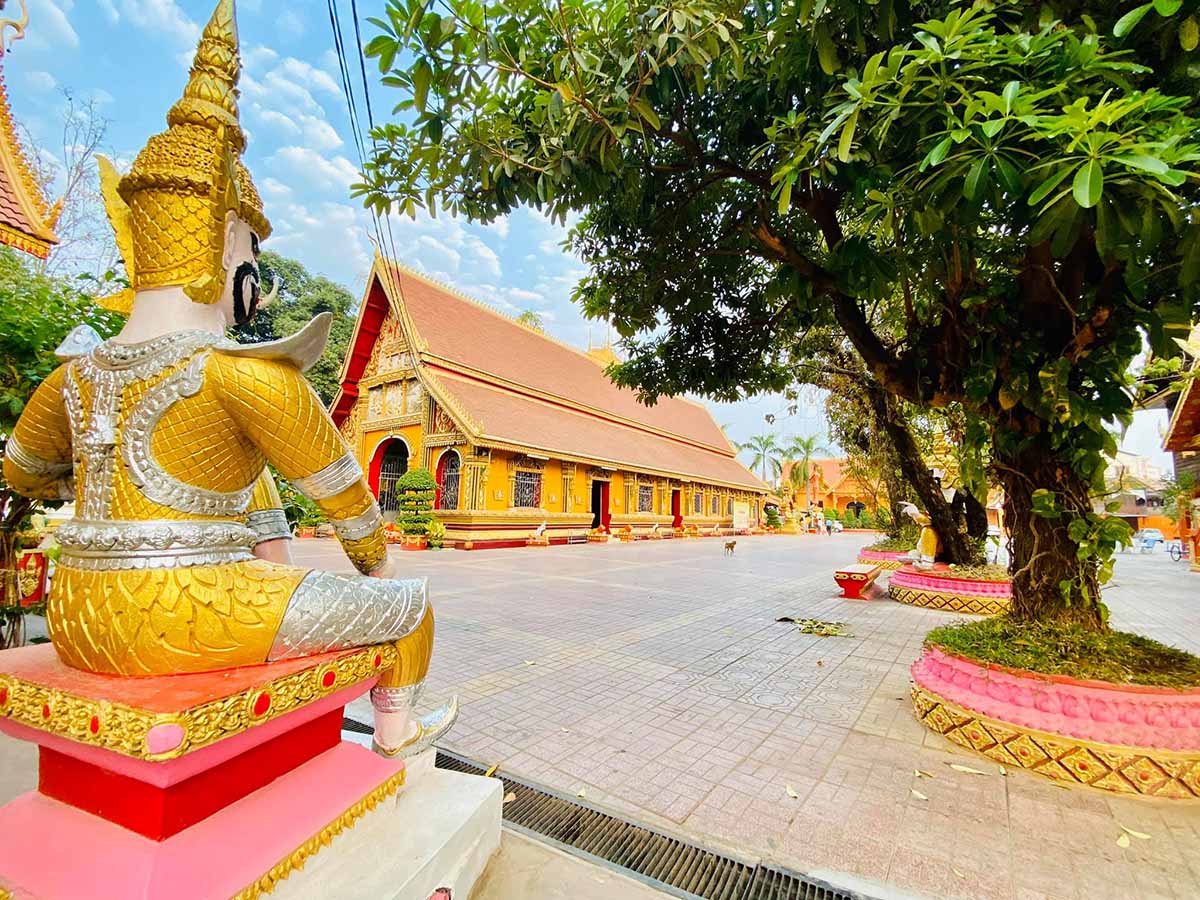
Wat Si Muang
According to local belief, during the construction of Si Muang Pagoda, the builders met a significant subsurface water source that hampered their labor. Ms. Si sacrificed herself as a stopper to stop the flow to prevent the water source from erupting. Faced with the young woman's sincere heart, the people named the temple after Ms. Si until today. It was an amazing experience when I directly witnessed a testament to a meaningful legend.
Wat Wisunarat
-
Location: Wisunarat Road, Luang Prabang
-
Opening hours: 6 AM – 6 PM daily
-
Fee: 20.000 Kip (~1.02 USD)
Wat Wisunarat was named after King Wisunarat (Visoun), who governed Laos from 1501 to 1520. Dating back to the 16th century, it is one of the oldest and most cherished Laos temples.
At its heart lies the remarkable That Makmo Stupa, a structure resembling a watermelon and richly adorned with detailed stucco work. Wat Wisunarat remains an active center of worship and spirituality, where the serene atmosphere invites visitors to immerse themselves in the living traditions of Buddhism.

Wat Wisunarat
The temple's architecture is special because of its elegant simplicity. A distinguishing feature is a European-style roof that is pitched oddly in Laos. Besides, the facade of Wat Wisunarat was decorated with intricate carvings and wooden fretwork that reflect the artistic craftsmanship of the time. With its historical significance and cultural prominence, Wat Wisunarat is a testament to the enduring spiritual heritage of Luang Prabang.
It is also a captivating destination for those seeking to explore the rich tapestry of Laos' cultural history. Leaving Wat Wisunarat, I carried with me a sense of peace and wonder. The temple allowed me to explore the architectural and artistic treasures of Laos.
Buddha Park
-
Location: 25 km southeast of Vientiane, in a meadow by the Mekong River
-
Opening hours: 8 AM - 5 PM
-
Fee: 15,000 Kip (~0.75 USD)
Buddha Park, also known as Xieng Khuan, is a unique and enchanting sculpture park. Buddha Park is an open-air sculpture garden, featuring a mesmerizing collection of more than 200 statues and sculptures. These sculptures are a harmonious blend of Buddhist and Hindu imagery. They vary in size, style, and artistic detail.

Buddha Park
The most recognizable and central piece is a colossal pumpkin-shaped structure. Visitors can enter this pumpkin through a small opening and climb through various levels, each representing different stages of human life and the Buddhist concept of reincarnation.
Buddha Park is a place where art, spirituality, and nature coalesce converge. This place creates a unique and thought-provoking destination for those interested in exploring the cultural and religious facets of Laos.
Discover more insights on Laos travel guide!
Haw Phra Kaew
-
Location: At the center location of Vientiane, the capital city of Laos and just opposite Wat Sisaket Temple
-
Opening hours: 8 AM – 12 AM & 1 PM – 4 PM
-
Fee: 5000 Kip per person (~0.25 USD)
Haw Phra Kaew was originally constructed in 1565 as a royal residence for King Setthathirath. This place later served as a repository for the highly revered Emerald Buddha image. The temple's name is "Haw Phra Kaew," which translates to "The Temple of the Emerald Buddha. The temple housed the Emerald Buddha image, but in 1779 it was eventually taken to Thailand, where it now resides in Bangkok's Wat Phra Kaew.
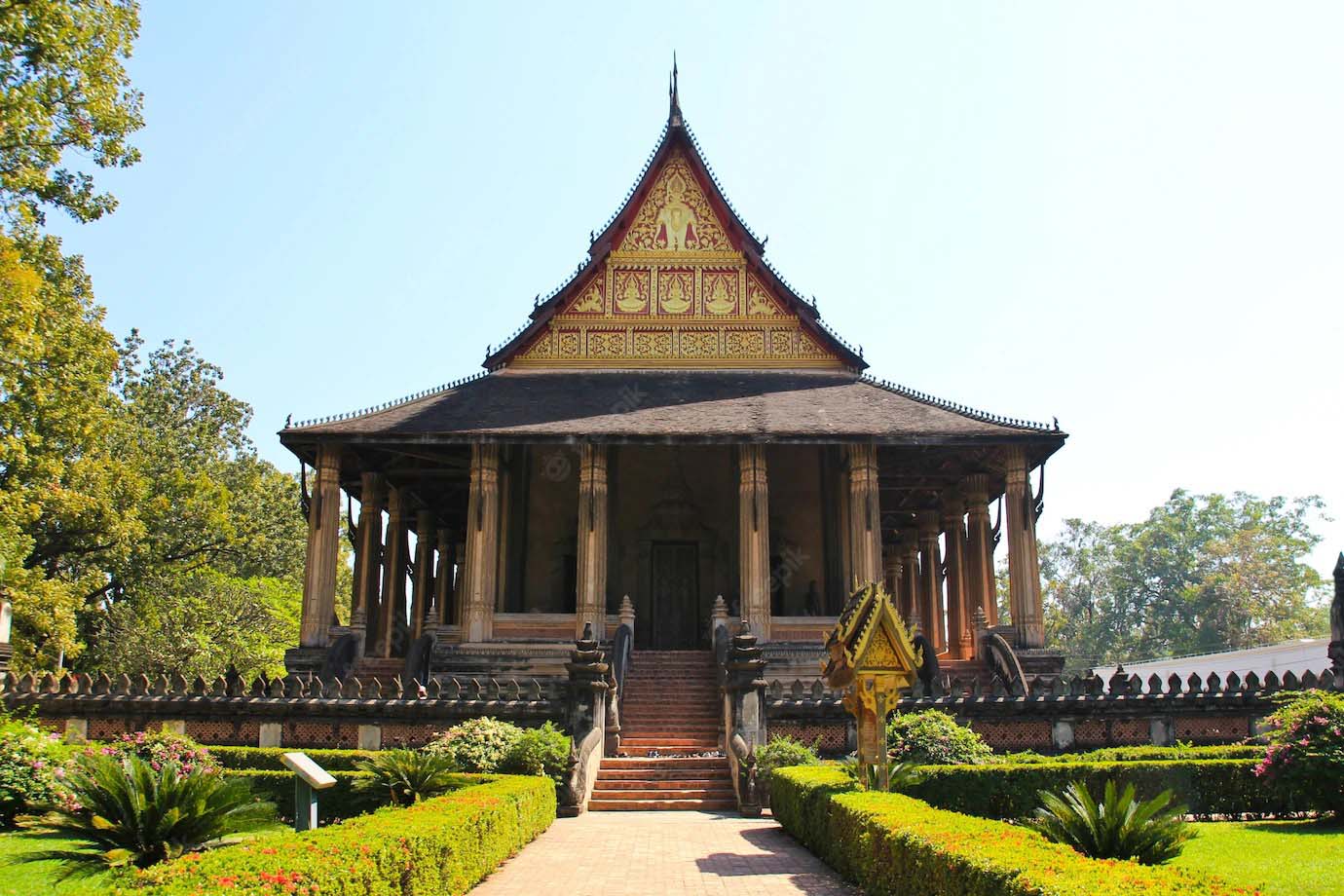
Haw Phra Kaew
However, Haw Phra Kaew continues to serve as a place of worship, housing various Buddha images and religious relics. Visitors can explore the interior of the temple, adorned with colorful murals depicting Buddhist stories and legends.
In addition to its religious significance, Haw Phra Kaew functions as a museum and cultural center. It houses a diverse collection of Buddhist art, sculptures, and artifacts, providing visitors with insights into the religious and historical heritage of Laos temples.
Wat Sisaket
-
Location: On Lan Xang Road, on the corner of Setthathirath Road, to the northwest of Haw Phra Kaew
-
Opening hours: 8 AM - 4 PM
-
Fee: 5000 Kip per person (~0.25 USD)
Wat Si Saket was constructed in 1818 during the reign of King Anouvong, the last monarch of the Lan Xang Kingdom. It is one of the few Laos temples to have survived the sacking of the city by the Siamese (Thai) forces in 1828. That’s why it is one of the oldest temples in the capital.

Wat Sisaket
The temple's architecture is a remarkable blend of Lao and Siamese (Thai) styles, reflecting the historical ties between the two nations. It features a cloister wall that encloses the temple complex, adorned with thousands of small niches containing miniature Buddha statues. These niches create a mesmerizing visual effect, offering a glimpse into the devotional practices of the past.
What impresses visitors is that all the Buddha statues here have lost a few parts and all have lost their heads. The temple was destroyed numerous times throughout the conflict due to its high spiritual and monetary qualities. It has become a treasure trove of Laos' most ancient values due to its powerful and lasting vitality.
Pak Ou Caves
-
Location: 25 Kilometers North of Luang Prabang on the limestone cliffs overlooking the Mekong River
-
Opening hours: 8 AM - 5 PM
-
Fee: 20,000 Kip (~0.99 USD)
Pak Ou Caves is very different from the other well-known Laos temples. Upon arriving, I was surprised by the rugged limestone cliffs that cradled the caves, their ancient presence casting a mystical aura. The caves consist of two main grottoes, the Tham Ting (Lower Cave) and the Tham Phum (Upper Cave)
You can access The Tham Ting cave by a short climb of stone steps. The Tham Ting is the lower cave filled with an astounding collection of over 2,500 Buddha statues and figurines. These statues come in various sizes and materials, from wood and stone to bronze and resin. They are offered by devotees as a symbol of reverence and devotion to the Buddhist faith.
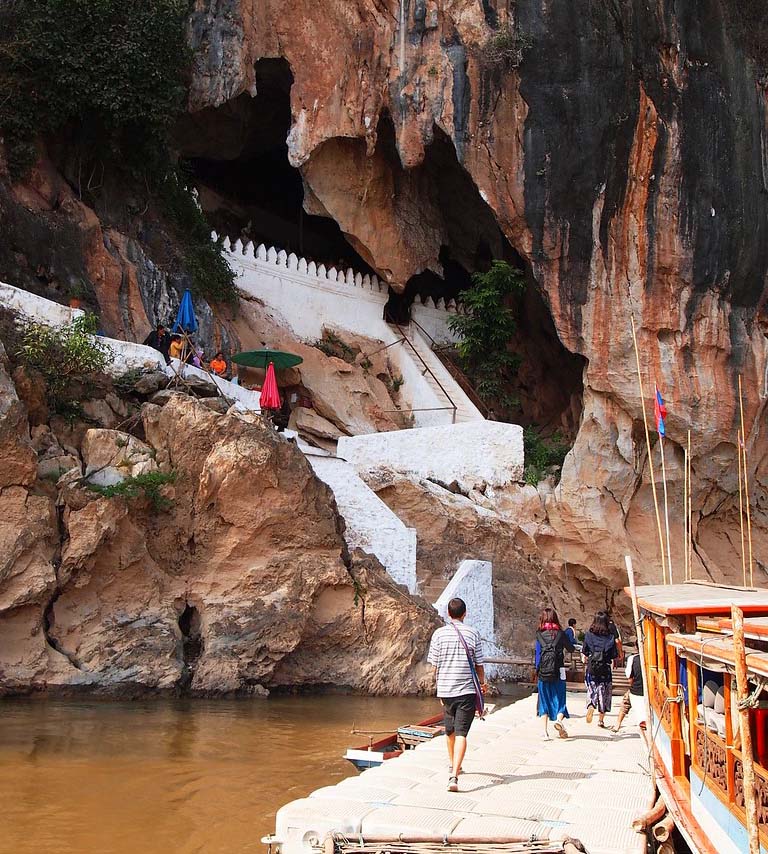
Pak Ou Caves
Above the Tham Ting lies the Tham Theung, the upper cave. While it also contains Buddha statues, it is less frequented by visitors and has a more serene and meditative atmosphere. You will witness the most attractive portion of Tham Phum cave at the entry at the end of the route, which is a wonderfully sculpted and adorned door.
Beyond the caves themselves, the location of the Pak Ou Caves is simply breathtaking. The cave nestles amidst limestone cliffs and offers panoramic views of the Mekong River and the surrounding landscape. According to my experience, the journey to reach the caves, whether by boat or a scenic drive, will also add to the overall charm of the visit.
What is Do and Don’t in Laos Temples
You should follow these rules to have a thorough visit to the temple
Do:
-
Dress Modestly: Wear clothing that covers your shoulders, chest, and knees. Avoid wearing revealing or skimpy outfits when visiting temples.
-
Remove Your Shoes: Always remove your shoes before entering temple buildings or sacred areas. You'll often find designated places to leave your footwear.
-
Ask for Permission: If you want to take photographs inside a temple or of monks, ask for permission first. Some temples may have restrictions on photography.
-
Give Alms Mindfully: If you wish to offer alms to monks, do so with mindfulness. Keep a respectful distance, and don't touch the monks. Women should avoid direct contact with monks.

Following the rules will ensure that you have a pleasant experience
Don’t:
-
Don't Raise Your Voice: Speak softly and avoid shouting or speaking loudly within temple grounds. Temples are places of serenity and reflection.
-
Don't Interrupt Monks: If monks are in prayer or meditation, do not disrupt them. Keep a respectful distance and observe quietly.
-
Don't Bring Pets: It's considered disrespectful to bring pets into temple grounds, as they can be seen as a distraction or disturbance.
-
Don't Smoke or Chew Gum: Smoking and chewing gum are typically not allowed on temple grounds.

You must be careful to avoid doing the wrong things
Laos temples are not just architectural wonders but also spiritual sanctuaries. They offer a profound glimpse into the cultural and religious heritage of this beautiful Southeast Asia nation. If you are interested in these sacred sites and want to learn more about the beauty of Laos, contact New Asia Tours to choose a suitable itinerary.


